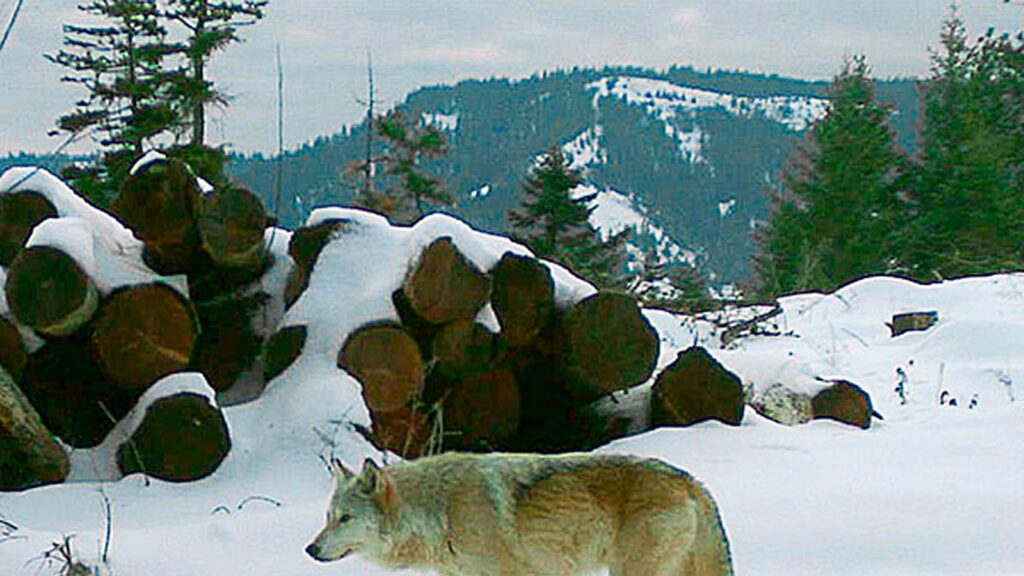For millennia people have tried to scare wolves away from their livestock. Most of them didn’t have drones.
However a crew of biologists working close to the California-Oregon border do, and so they’re utilizing them to blast AC/DC’s “Thunderstruck,” film clips and dwell human voices on the apex predators to shoo them away from cattle in an ongoing experiment.
“I’m not placing up with this anymore!” actor Scarlett Johansson yells in a single clip, from the 2019 movie “ Marriage Story.”
“With what? I can not speak to individuals?” co-star Adam Driver shouts again.
Grey wolves had been hunted practically to extinction all through the U.S. West by the primary half of the twentieth century. Since their reintroduction in Idaho and at Yellowstone Nationwide Park within the mid-Nineties, they’ve proliferated to the purpose {that a} inhabitants within the Northern Rockies has been faraway from the endangered species record.
There at the moment are tons of of wolves in Washington and Oregon, dozens extra in northern California, and thousands roaming close to the Nice Lakes.
The recovering inhabitants has meant growing battle with ranchers — and more and more inventive efforts by the latter to guard livestock. They’ve turned to electrified fencing, wolf alarms, guard canines, horseback patrols, trapping and relocating, and now drones. In some areas the place nonlethal efforts have failed, officers routinely approve killing wolves, together with final week in Washington state.
Grey wolves killed some 800 domesticated animals throughout 10 states in 2022, a earlier Associated Press review of information from state and federal businesses discovered.
Scientists with the USDA Animal and Plant Well being Inspection Service developed the methods for hazing wolves by drone whereas monitoring them utilizing thermal imaging cameras at evening, when the predators are most lively. A preliminary examine launched in 2022 demonstrated that including human voices by a loudspeaker rigged onto a drone can freak them out.
The crew documented profitable interruptions of wolf hunts. When Dustin Ranglack, the USDA’s lead researcher on the venture, noticed one for the primary time, he smiled from ear to ear.
“If we might cut back these adverse impacts of wolves, that’s going to be extra more likely to result in a state of affairs the place we’ve got coexistence,” Ranglack stated.
The preloaded clips embody recordings of music, gunshots, fireworks and voices. A drone pilot begins by enjoying three clips chosen at random, such because the “Marriage Story” scene or “Thunderstruck,” with its screams and hair-raising electrical guitar licks.
If these do not work, the operator can improvise by yelling by a microphone or enjoying a distinct clip that is not among the many randomized presets. One favourite is the heavy metallic band Five Finger Death Punch ‘s cowl of “Blue on Black,” which could blast the lyric “You turned and also you ran” because the wolves flee.
USDA drone pilots have continued cattle safety patrols this summer time whereas researching wolf responses at ranches with excessive battle ranges alongside the Oregon-California border. Patrols prolonged south to the Sierra Valley in August for the primary time, based on the California Division of Fish and Wildlife.
It’s unclear whether or not the wolves may turn into accustomed to the drones. Herders and wolf hunters in Europe have lengthy deterred them with lengthy traces hung with flapping material, however the wolves can ultimately be taught that the flags usually are not a risk.
Environmental advocates are optimistic about drones, although, as a result of they permit for scaring wolves in several methods, elsewhere.
“Wolves are scared of novel issues,” stated Amaroq Weiss, a wolf advocate with the Middle for Organic Range. “I do know that within the human creativeness, individuals consider wolves as huge, scary critters which are afraid of nothing.”
There are additionally drawbacks to the expertise. A drone with evening imaginative and prescient and a loudspeaker prices round $20,000, requires skilled coaching and would not work nicely in wooded areas, making it impractical for a lot of ranchers.
Ranchers in Northern California who’ve hosted USDA drone patrols agree that they’ve lowered livestock deaths to date.
“I’m very appreciative of what they did. However I don’t assume it’s a long-term answer,” stated Mary Rickert, the proprietor of a cattle ranch north of Mount Shasta. “What I’m afraid of is that after some time frame, that rapidly they go, ‘Wow, this isn’t going to harm me. It simply makes numerous noise.’”
Ranchers are compensated if they’ll show {that a} wolf killed their livestock. However there are uncompensated prices of getting stressed-out cows, resembling decrease beginning charges and more durable meat.
Rickert stated if the drones do not work over the long run, she might need to shut the enterprise, which she’s been concerned in since not less than the Eighties. She needs permission to shoot wolves in the event that they’re attacking her animals or if they arrive onto her property after a sure variety of assaults.
If the expertise proves efficient and prices come down, sometime ranchers may merely must ask the wolves to go away.
Oregon-based Paul Wolf — sure, Wolf — is the USDA’s southwest district supervisor and the primary 5 Finger Loss of life Punch fan among the many drone pilots. He recalled an early encounter throughout which a wolf at first merely appeared curious on the sight of a drone, till the pilot talked to it by the speaker.
“He stated, ‘Hey wolf — get out of right here,’” Wolf stated. “The wolf instantly lets go of the cattle and runs away.”

